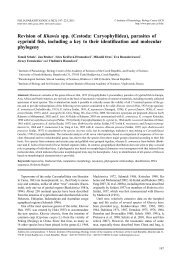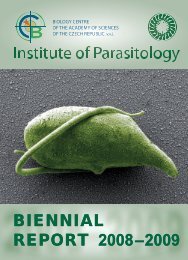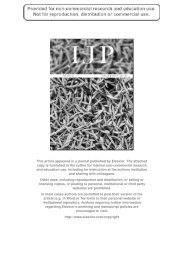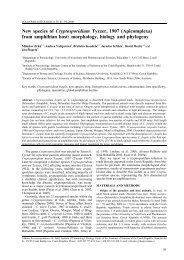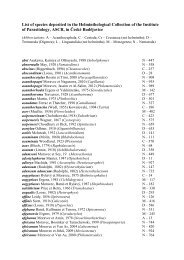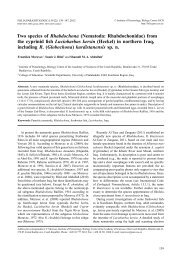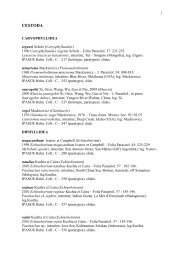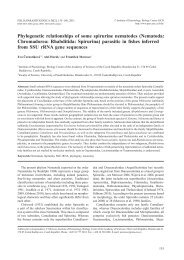Coccidia of rabbit: a review
Coccidia of rabbit: a review
Coccidia of rabbit: a review
You also want an ePaper? Increase the reach of your titles
YUMPU automatically turns print PDFs into web optimized ePapers that Google loves.
tem <strong>of</strong> lagomorphs. In terms <strong>of</strong> structure and function, it<br />
does not share characteristics with other mammals. The<br />
young <strong>rabbit</strong> appendix is involved in diversification <strong>of</strong><br />
the B-cell antibody repertoire (Weinstein et al. 1994,<br />
Mage 1998a) and therefore this organ is considered to be<br />
a bursal equivalent. Ig gene diversification in the <strong>rabbit</strong><br />
GALT starts with the rearrangement <strong>of</strong> mainly a single<br />
(V H 1) gene (Sehgal et al. 1998). Secondary diversification<br />
in germinal centres involves both somatic hypermutation<br />
and a gene conversion-like mechanism, a process<br />
that starts about two weeks after birth (Mage 1998b). The<br />
appendix at birth contains no organised B- or T-cell follicular<br />
regions. By six weeks old, the appendix contains<br />
B-cells in germinal centres and dome regions. No T-cells<br />
are found in either <strong>of</strong> these regions, but are detectable in<br />
the interfollicular region. Starting at 9 weeks after birth<br />
T-cells are present in domes and later in follicles. These<br />
changes may correspond to changes in function (Mage<br />
1998b). Sacculus rotundus is another component <strong>of</strong><br />
GALT in <strong>rabbit</strong>s with a very similar structure and probably<br />
function as the appendix. The other lymphoid organs<br />
in <strong>rabbit</strong>s are similar in terms <strong>of</strong> ontogeny, structure and<br />
function to their counterparts in other mammals. Interestingly,<br />
the components <strong>of</strong> GALT are the specific site <strong>of</strong> the<br />
endogenous development <strong>of</strong> E. coecicola (see above).<br />
The most thorough study in <strong>rabbit</strong>s was performed by<br />
Renaux et al. (2003), who studied various immunological<br />
parameters after a primary infection with E. intestinalis.<br />
They noted transient increase in the percentage <strong>of</strong> intestinal<br />
CD4+ lymphocytes and MLN CD8+, 14 days postinoculation<br />
(DPI) and strong increasing in the percentage<br />
<strong>of</strong> intestinal CD8+ cells, from 14 DPI onwards. Extensive<br />
infiltration <strong>of</strong> lamina propria with CD8+ lymphocytes was<br />
observed 14 DPI. The specific lymphocyte proliferation<br />
induced in vitro by parasite antigens was obtained from<br />
MLN cells, but not from splenocytes. The specific IgG<br />
titres in the serum were only slightly enhanced. The authors<br />
concluded that protection against infection is due<br />
to an effective mucosal immune response, while systemic<br />
responses increase only after successive infections and<br />
are only reflections <strong>of</strong> repeated encounters with parasite<br />
antigens.<br />
Pakandl et al. (2008a) performed a comparative study<br />
<strong>of</strong> the immune response elicited by infection with the<br />
highly immunogenic coccidium E. intestinalis and weakly<br />
immunogenic species E. flavescens. The only apparent<br />
difference in the immune responses was a marked<br />
enhancement <strong>of</strong> the percentage <strong>of</strong> CD8+ cells in the epithelium<br />
<strong>of</strong> the ileum, the site specific for E. intestinalis,<br />
whereas no significant changes were noted after infection<br />
with E. flavescens in the caecum. These results suggest<br />
the importance <strong>of</strong> the local immune response.<br />
Pakandl et al. (2008b) studied dependence <strong>of</strong> the immune<br />
response on the age <strong>of</strong> young <strong>rabbit</strong>s infected with<br />
E. intestinalis and E. flavescens. Unlike the antibody re-<br />
160<br />
sponse, the parameters reflecting cellular immunity (total<br />
number <strong>of</strong> leukocytes in MLN, lymphocyte proliferation<br />
upon stimulation with specific antigen and the dynamics<br />
<strong>of</strong> CD4+ and CD8+ cell proportions in the intestinal<br />
epithelium at the specific site <strong>of</strong> parasite development)<br />
were significantly changed from about 25 days <strong>of</strong> age onwards.<br />
The absence <strong>of</strong> a significant humoral response may<br />
be connected with successive maturation <strong>of</strong> the immune<br />
system (see above). As in older animals, the only marked<br />
difference between <strong>rabbit</strong>s inoculated with both coccidia<br />
was observed in the dynamics <strong>of</strong> CD4+ and CD8+ cells in<br />
the epithelium <strong>of</strong> the specific site <strong>of</strong> parasite development.<br />
Significant changes were noted after infection with E. intestinalis,<br />
but not in <strong>rabbit</strong>s infected with E. flavescens<br />
(except CD4+ cells in the <strong>rabbit</strong>s inoculated at 33 days<br />
<strong>of</strong> age). As the immune system <strong>of</strong> sucklings from about<br />
25 days <strong>of</strong> age onwards reacts to the infection, this age<br />
may be considered in terms <strong>of</strong> vaccination against coccidiosis.<br />
The immune response to coccidia infection was studied<br />
almost exclusively on chicken or mice model and the<br />
results were several times <strong>review</strong>ed (Wakelin and Rose<br />
1990, Ovington et al. 1995, Rose 1996, Lillehoj 1998,<br />
Yun et al. 2000, Lillehoj et al. 2004).<br />
In contrast, there are only few works dealing with immune<br />
response <strong>of</strong> <strong>rabbit</strong>s to coccidiosis. Thus, a detailed<br />
comparison <strong>of</strong> the immune response to the infection <strong>of</strong><br />
coccidia in <strong>rabbit</strong>s and chicken or mouse models would be<br />
difficult. Nevertheless, no fundamental differences were<br />
found.<br />
Evidence from experiments performed mostly in<br />
chickens or mice implicate that cell-mediated immunity,<br />
including very complex network <strong>of</strong> cytokines, cytotoxic<br />
effects and other mechanisms, plays a major role in the<br />
protection against coccidiosis. It has been shown that<br />
CD4+ T-cells and, for some species <strong>of</strong> Eimeria, CD8+<br />
T-cells are important in immune responses that limit parasite<br />
infection during primary infection. In subsequent infections,<br />
parasite reproduction is limited by CD8+ and, to<br />
a lesser extent, CD4+ cells (Wakelin and Rose 1990, Rose<br />
et al. 1992, Rose 1996, Lillehoj 1998, Schito et al. 1998,<br />
Yun et al. 2000, Shi et al. 2001, Lillehoj et al. 2004).<br />
6.1. IMMunIty and MIgratIon <strong>of</strong> sporozoItes<br />
Pakandl et al. (2006) noted significantly reduced numbers<br />
<strong>of</strong> sporozoites <strong>of</strong> E. coecicola in extraintestinal sites<br />
(spleen and MLN) and in the appendix <strong>of</strong> immune <strong>rabbit</strong>s.<br />
Similarly, the number <strong>of</strong> sporozoites <strong>of</strong> E. intestinalis was<br />
markedly lower in the ileal crypts <strong>of</strong> immune animals as<br />
compared with their naïve counterparts.<br />
Indeed, hampering <strong>of</strong> migration <strong>of</strong> sporozoites may be<br />
considered as one <strong>of</strong> the mechanisms involved in host defence<br />
against coccidia. Such a strategy may be employed<br />
due to the specific behaviour <strong>of</strong> parasites in the host organism.



